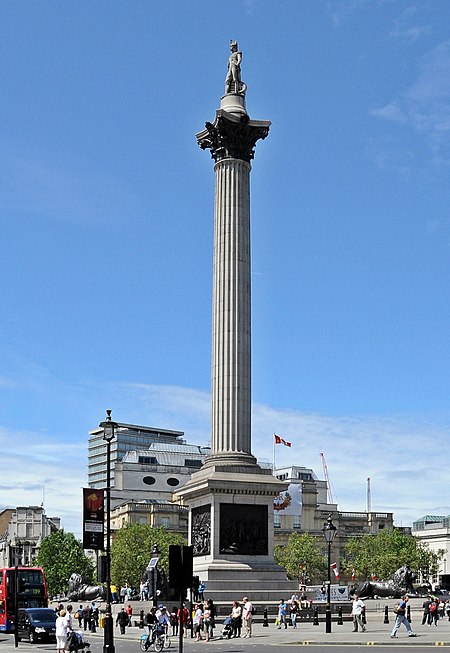Nelson's Column

Nelson's Column is a monument in Trafalgar Square in the City of Westminster, Central London, built to commemorate Admiral Horatio Nelson, who died at the Battle of Trafalgar in 1805. The monument was constructed between 1840 and 1843 to a design by William Railton at a cost of £47,000 (equivalent to £4,717,346 in 2020). It is a column of the Corinthian order built from Dartmoor granite. The statue of Nelson was carved from Craigleith sandstone by sculptor Edward Hodges Baily. The four bronze lions around its base, designed by Sir Edwin Landseer, were added in 1867.The pedestal is decorated with four bronze relief panels, each 18 feet (5.5 m) square, cast from captured French guns. They depict the Battle of Cape St. Vincent, the Battle of the Nile, the Battle of Copenhagen and the death of Nelson at Trafalgar. The sculptors were Musgrave Watson, William F. Woodington, John Ternouth and John Edward Carew, respectively. It was refurbished in 2006 at a cost of £420,000 (equivalent to £621,277 in 2020), at which time it was surveyed and found to be 14 feet 6 inches (4.42 m) shorter than previously supposed. The whole monument is 169 feet 3 inches (51.59 m) tall from the bottom of the pedestal to the top of Nelson's hat.
Excerpt from the Wikipedia article Nelson's Column (License: CC BY-SA 3.0, Authors, Images).Nelson's Column
Trafalgar Square, London Covent Garden
Geographical coordinates (GPS) Address Nearby Places Show on map
Geographical coordinates (GPS)
| Latitude | Longitude |
|---|---|
| N 51.507722222222 ° | E -0.12797222222222 ° |
Address
Trafalgar Square
Trafalgar Square
WC2N 5DP London, Covent Garden
England, United Kingdom
Open on Google Maps








